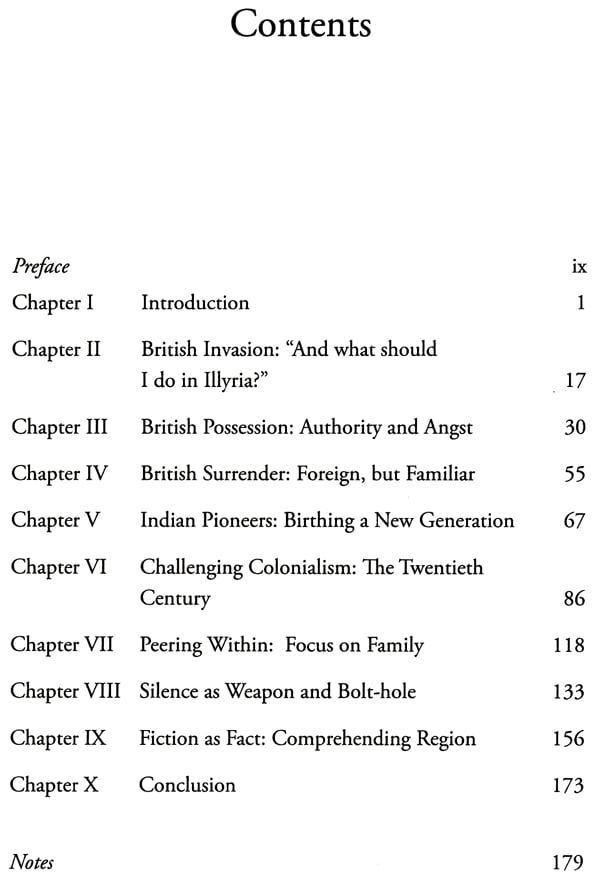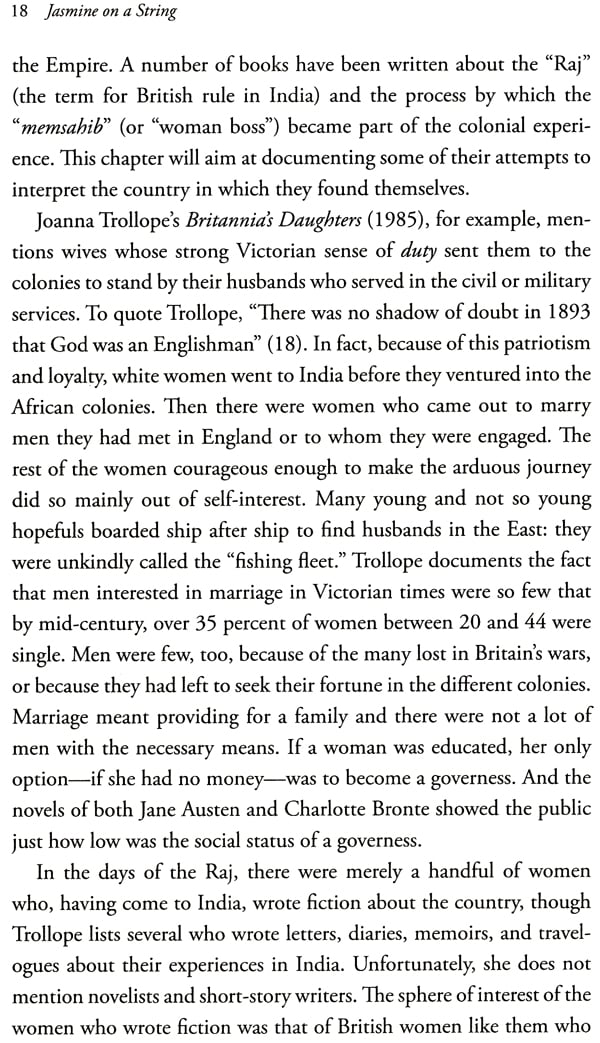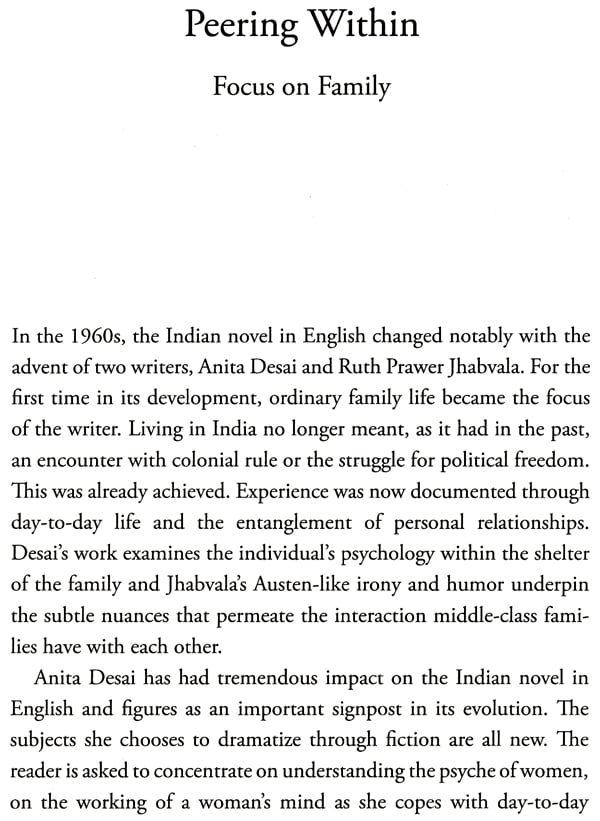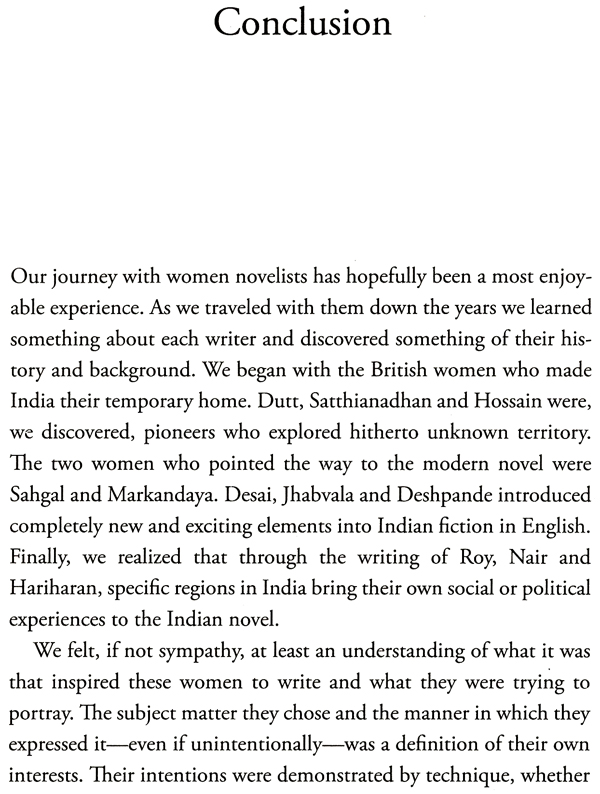
Jasmine on a String (A Survey of Woman Writing English Fiction in India)
Book Specification
| Item Code: | NAR843 |
| Author: | Margaret Paul Joseph |
| Publisher: | Oxford University Press, New Delhi |
| Language: | English |
| Edition: | 2014 |
| ISBN: | 9780199452484 |
| Pages: | 212 |
| Cover: | HARDCOVER |
| Other Details | 9.00 X 6.00 inch |
| Weight | 370 gm |
Book Description
Born in India, Margaret Paul Joseph earned her doctorate in English Literature from Temple University, Philadelphia, and now lives in USA. She won a Gold Medal for English from the University of Madras, India, and was awarded a British Council scholarship to research at the University of Leeds, the Commonwealth Institute, London, and the Institute for Colonial Studies, Oxford. She taught English and the Literature of the British Commonwealth to under-graduate and graduate students for twenty-five years. Jasmine on a String: A Survey of Women Writing English Fiction in India is her fifth book. Her previous publications include Kamala Markandaya (1980), Caliban in Exile: The Outsider in Caribbean Fiction (1992), Bequest of Wings (1994), and an e-book on educational programs for adults.
My goal in writing this book is to interest students, as well as the general public, in the English fiction of women who live or lived in India. The novels I have chosen are based on that premise. They have the kind of authorial involvement that demonstrates certain integrity of purpose: India is the geographical context, people living in India are the characters dramatized.
At the outset, I asked myself if I should examine only the work of writers who were born in India or if I could include those who merely lived there. What of the British women who chose India as their domicile during the Raj and who turned their experiences into readable fiction? Did they, as well as Rudyard Kipling, Hilton Brown, or Meadows Taylor, not deserve to be considered? Yes, they did, I decided, after reading the books that were available to me, either in hard copy or on Google's wonderful database that includes so many out of print books that would otherwise be lost to the public. Here again, it was easy to avoid fiction that smacked of kitsch or pretentiousness. I soon realized that this was a treasure trove of material about which few people seem to be aware. The British men who wrote fiction and poetry have been published, anthologized and perused. Not so the British women.
My purpose in bringing them to public notice is two-fold-they were part of the colonial experience and, some would say, demonstrate the underbelly of colonialism. For a time, they were part of the experience of what it meant to live in India. I do not think that they should be sidelined in favour of their male counterparts, just because their vision was controversial, their narration was biased, or their perception of India was sometimes racist. Most readers today have sufficient self-confidence to deal with these prejudices and are objective enough to cope with the politically incorrect. A global public would find their stories about India interesting because the focus is unusual. The very fact that their lives in India were so different from those of native writers is reason to examine and evaluate their work, not to forget or ignore them. Unlike the British women, most Indian women novelists are known and appreciated. Sales of their fiction are proof of their popularity.
My interest in Indian fiction in English began in the years when I taught the subject to undergraduate and graduate students in the city of Chennai (that used to be called Madras at the time). In the 1970s, what was called "Indian Writing in English" was introduced in English departments in some universities. The novels of men such as R.K. Narayan, Raja Rao, Mulk Raj Anand, and Bhabani Bhattacharya began to appear in the curriculum, and fiction by women like Nayantara Sahgal and Kamala Markandaya, for example, followed suit. Indian Writing in English (1958), K.R. Srinivasa Iyengar's pioneering history of the writing in English of novelists, poets, and politicians provided the necessary background.
I began to read widely in the field, especially those novels writ-ten by women, because they were writing about my own country, not about some far-off English village or moor. They were helping me discover what people in other parts of India did, what they thought and how they behaved in rural India, in urban society, or in the world of politics.
A number of books have been written over the past half-century about the genre variously labelled the "Indo-Anglian novel" or the "Anglophone" novel or (less ponderously) just "the Indian novel in English." Indian novelists have earned international status by winning various international awards and prizes. Critics in many countries have won recognition for their analysis of Indian authors. A few surveys of Indian fiction, non-fiction, and poetry in English have been published. What has not been done is an attempt to track sign-posts on the journey taken by women novelists who live (or lived) in India, but wrote in English. While feminist critics in the West have done their bit to bring their own writers to public attention in literary histories, little has been done to cover the spectrum of female English-writing novelists in India. This is what I attempt to do in the following pages.
Until recently, even those who wrote in their own languages for centuries were unknown or unacknowledged. They finally found recognition in Women Writing in India, edited by Susie Tharu and K. Lalita (1991), an accomplished pioneering work in two volumes. The discovery of women writers dating from seventh century BC onwards opened our eyes to the ocean of writing in vernacular languages that exists and waits to be translated into English. Subjects range from religious poetry to autobiographies, from reform literature to short stories. Tharu and Lalita's encyclopedic work researches and validate the women who wrote because they needed to express themselves. The introductory essays to these volumes are distinguished contributions to the development of women's writing in India and mandatory reading for anyone interested in the subject, but they do not cover all its aspects. They do not include the creative work of women who wrote in English.
Female critics from other countries are beginning to notice post-colonial fiction in English by British women who lived in different parts of the British Empire. For - example, in Colonial Strangers: Women Writing the End of the British Empire (2004), Phyllis Lassner discusses women novelists who wrote about their experience of living in Africa, the Caribbean, the Middle East and India. My purpose is to survey chronologically the literature written in English by women in India, both British and Indian. And my choice of writers is based on two rules: they should have lived in India, not just traveled for a time in the country; and they should be writing fiction about India in the English language.
There were other European countries from where women came to India. Portuguese, Dutch, and French women either accompanied or later joined their men when their countries attempted colonization. European cemeteries in India prove that women did arrive on Indian shores, lived in different parts of the country and died there. One of the saddest cemeteries may be the small enclosure in Sadras, south of Chennai (Madras), testament to the young Dutch women who died of disease or in childbirth. The Government of Portugal made it a policy to send women to marry their officers in Goa after it became known that the men were consorting with "native" women.
**Contents and Sample Pages**













